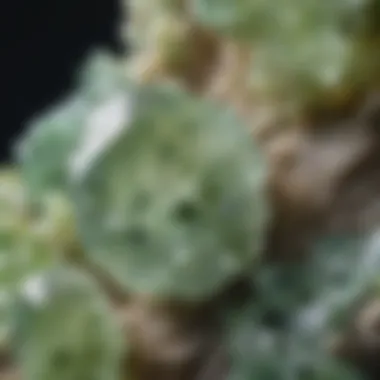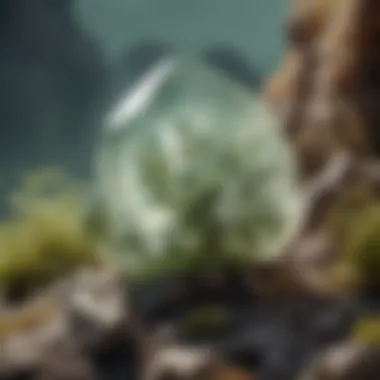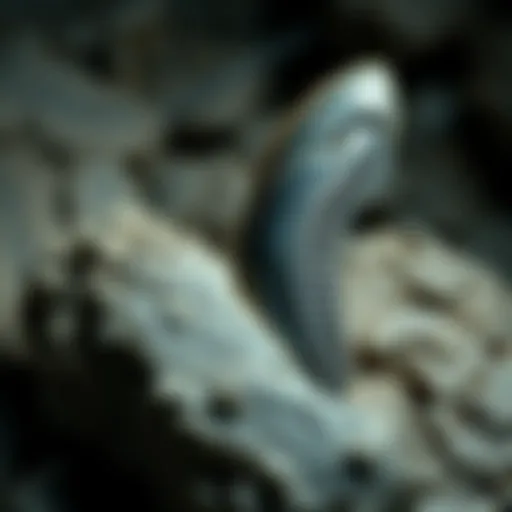Exploring the Unique Properties and Significance of Prehnite


Intro
Prehnite, a mineral of captivating beauty and intriguing properties, has garnered the attention of collectors, geologists, and metaphysical practitioners alike. Its soft hues of green, yellow, and sometimes even blue lend it a unique aesthetic, making it a favored choice among those who appreciate the intricacies of nature's creations. Beyond its visual appeal lies a wealth of geological significance and historical relevance, which serves as a backdrop for its enduring allure.
Formed under specific conditions involving the alteration of volcanic rocks, prehnite's genesis is a tale of elemental transformation. Enthusiasts often seek to understand not just what prehnite is, but how it comes to exist and why it holds a place of esteem in various cultures. This article aims to provide a comprehensive overview of prehnite’s many facets, from its physical and chemical properties to its applications in geology and beyond.
As we delve deeper into the characteristics that define prehnite, we will also explore its significance to collectors who are always on the lookout for that next remarkable find. Enthusiasts and professionals alike will find value in the discussion of identification techniques, preservation methods, and the metaphysical meanings attributed to this mineral. By the end, we hope readers will have a clearer perspective on the role prehnite plays not only in the world of minerals but also in our understanding of Earth’s history and the human experiences interwoven with it.
Featured Collectible of the Month
Overview
Each month, we highlight an exceptional mineral that stands out for its rarity, color, and story. This month, prehnite takes center stage. Often likened to jade for its vibrant colors, prehnite shines with a transparency and softness that captures attention. The mineral, predominantly found in places like South Africa, China, and the United States, boasts a unique blend of beauty and history, making it a must-have for serious collectors.
Historical Significance
Prehnite, first described in the late 18th century by the Dutch geologist Hendrik von Prehn, has a rich history tied to its jurisdictions of discovery. Renowned for its use by various indigenous cultures and its frequent appearance in jewelry and ornamentation, it has long been associated with a variety of meanings ranging from protection during travel to emotional healing. In the realm of geology, prehnite's formation sheds light on the conditions present in ancient volcanic environments, offering insights into Earth’s dynamic processes.
"Prehnite is more than just a pretty face; it carries a legacy that spans cultures and centuries, encapsulating the living history of our planet."
Identification Techniques
Visual Characteristics
Understanding prehnite begins with recognizing its distinct visual traits. Experienced eyes can identify it through several features:
- Color: Typically a pale green or yellow, sometimes exhibiting deeper shades.
- Luster: A vitreous or pearly sheen that can catch light elegantly.
- Transparency: Ranges from transparent to translucent, often showcasing beautiful inclusions.
- Crystal Form: Prehnite commonly forms in botryoidal shapes resembling clusters of grapes.
Resources for Identification
For those seeking further expertise on identifying prehnite, several resources are available:
- The educational site Wikipedia provides an overview of the mineral's characteristics and significance.
- For discussions around collecting and identification, communities on Reddit can offer insights from fellow enthusiasts.
- Consider joining groups on Facebook that cater to collectors passionate about minerals.
In summary, understanding prehnite demands both an appreciation for its aesthetic qualities and an awareness of its scientific context, positioning it as a fascinating collectible with deep-seated significance in our natural world.
Prolusion to Prehnite
The allure of prehnite captivates not only mineral enthusiasts but also geologists, collectors, and laypeople alike. This remarkable mineral stands as a testimony to the breadth of geological processes that shape our planet. Understanding prehnite is more than just recognizing its physical characteristics; it’s about appreciating its underlying properties and how it fits within the larger tapestry of mineralogy. As we dig into the elements of prehnite, we uncover its multifaceted nature, linking its formation to significant geological events.
Definition and Basic Description
Prehnite is a relatively soft mineral, classified under the silicate group, primarily composed of calcium and aluminum. Its unique chemical structure plays a pivotal role in defining its appearance and significance. Typically, it exhibits a pale green to greenish-yellow hue, a characteristic that often endears itself to collectors. However, its color can vary and can include shades of white or gray, depending on the specific conditions of its formation. Most notably, prehnite forms in the presence of calcium-rich environments, derived primarily from the modification of volcanic rock.
When you lay eyes on prehnite, its translucent to opaque luster can evoke a sense of tranquility, reminiscent of serene natural settings. The mineral crystallizes in a tabular or prismatic form, further enhancing its aesthetic allure. Its Mohs hardness rating of about 6 to 6.5 means it’s relatively durable but can be scratched by harder minerals, demanding caution during storage and display.
Historical Context
The journey of prehnite through time is equally fascinating. Discovered in the late 18th century and named after the Dutch colonel Hendrik Prehn, this mineral boasts a rich history. Early on, researchers began to cultivate an understanding of its unique features, cementing its importance within geological studies. Interestingly, prehnite was among the first minerals to be associated with the concept of tectonic influences, especially in the context of metamorphism.
In various cultures, prehnite has held symbolic meanings, often linked to healing and protection. Throughout history, gemstones and minerals like prehnite have been imbued with metaphysical significance, thought to enhance intuition and promote emotional balance. This historical blend of geological study and cultural significance emphasizes not just the identity of prehnite as a mineral but also its place in human experience.
Understanding prehnite involves peeling back layers of geological and cultural history, revealing the depth of human fascination with this mineral. It acts as a microcosm for larger geological processes and human beliefs, making it a subject worthy of exploration.
Mineralogical Characteristics
Understanding the mineralogical characteristics of prehnite is essential for appreciating its diverse applications and natural significance. This section explores both its physical and chemical traits, forming the backbone of our understanding of this mineral. Each characteristic sheds light on prehnite's unique nature.
Physical Properties of Prehnite
Physical properties often serve as the first touchpoint in the identification and appreciation of a mineral. For prehnite, this encompasses its color variations, luster and clarity, and distinct crystal forms, each contributing unique attributes.
Color Variations
Prehnite is known for its captivating color variations, which can range from delicate pale green to more vibrant shades like brilliant yellow or even a faint blue. This diversity in color makes prehnite particularly appealing for those with an eye for aesthetics. Notably, the green hue often evokes imagery of tranquility and nature, contributing to its popularity among collectors and enthusiasts alike.
One unique feature of these color variations is that they can be influenced by the mineral's environment during formation. For example, certain trace elements can imbue the mineral with different colors, making each specimen distinct. However, while its beauty may be an advantage, it can also pose challenges during identification, as similar external conditions can lead to misleading attributes in color representation.
Luster and Clarity
The luster of prehnite is another noteworthy characteristic. It typically possesses a vitreous to silky sheen, depending on the specific conditions under which it formed. This sheen plays a crucial role in visual assessment and adds to the mineral’s overall appeal. Clarity, on the other hand, can vary sharply—while some specimens display transparency, others may be opalescent or even cloudy. This variability can enhance its desirability for collectors who appreciate the subtleties of natural phenomena.
A unique feature lies in how light interacts with prehnite, often highlighting its soft glow. This characteristic allows it to stand out among other minerals, though collectors must be cautious, as high clarity can also drive up its value.
Crystal Forms
When it comes to crystal forms, prehnite typically manifests as a compact mass or as lumpy aggregates, but it can form prismatic and tabular crystals under certain geological conditions. The geometric shapes not only highlight the mineral's intrinsic beauty but also speak to its formation processes.
Each crystal form presents its own advantages. Lumpy aggregates showcase a rugged aesthetic, which many collectors find appealing, while well-formed crystals might be more sought after for display. The unique feature of these shapes often piques interest during geological studies, marking them as indicators of specific formation scenarios.
Chemical Composition
Chemical composition provides insight into the mineral's structure and stability, essentially underpinning all its physical traits. For prehnite, understanding its silicate makeup and trace elements is crucial.
Silicate Composition
Prehnite is a member of the silicate mineral group, primarily composed of calcium, aluminum, silicate, and hydroxide. This fundamental silicate composition not only determines its stability but also its growth habits in various geological environments.
The interconnected silicate tetrahedra characterize its structure, influencing the mineral's hardness and other relevant attributes. One unique aspect of this composition is how it reacts to different environmental pressures during formation, leading to varied results. Still, this consistency allows a degree of predictability in recognizing prehnite against other minerals—an aspect particularly beneficial for geology enthusiasts.


Trace Elements
Trace elements in prehnite, such as iron and manganese, can significantly alter its color and physical properties. These minute quantities often serve as important identifiers in mineralogy, making understanding them paramount for accurate classification.
The presence of different trace elements not only affects appearance but can also influence the mineral’s stability over geological periods. This variability offers depth to the mineral's appeal—collectors often seek out specific specimens based on unique trace features. Collectively, these chemical components underscore the intricate relationship between prehnite's formation and its eventual identification and usage.
Formation and Occurrence
The formation and occurrence of prehnite offer valuable insights into both its geological narrative and its utility in various fields. Understanding how prehnite is formed and where it can be found helps mineral enthusiasts appreciate its significance. This section delves into two main areas: Geological settings, including igneous processes and metamorphic environments, as well as mining locations worldwide. Each of these facets plays a crucial role in the overall understanding of prehnite, its properties, and its applications.
Geological Settings
Igneous Processes
Igneous processes are crucial in the formation of prehnite, greatly influencing both its physical characteristics and where it can be located. These processes involve the crystallization of magma, which can create an environment rich in various minerals. A key characteristic of igneous processes is the high temperature and pressure conditions under which they occur. As magma cools slowly, prehnite begins to crystallize alongside other minerals, resulting in the unique formation we know and appreciate.
The abundance of vital trace elements found in the magma can contribute to the development of prehnite’s distinct hues and luster. The specific environment within igneous rocks can make it easier for collectors to find prehnite alongside other valued minerals, making igneous deposits a favored focus for geology enthusiasts.
Advantageously, the specific conditions of these igneous settings often lead to well-formed crystals, making them exceptionally beautiful and desirable for collectors. However, they can also be relatively scarce, leading to higher market values for well-sourced specimens.
Metamorphic Environments
Turning our gaze to metamorphic environments further highlights the versatility of prehnite’s formation. During metamorphism, prehnite forms under significant heat and pressure, often within existing rock formations. This transformation typically occurs in regions where tectonic activities take center stage, such as areas with limestone or basalt composition.
One key aspect of metamorphic environments is their capacity to produce varied and intricate structures in prehnite. This unique feature often endears itself to collectors, as every piece can tell a distinct story based on its geological history. The aesthetic appeal and rarity of well-formed prehnite crystals in metamorphic rock can significantly boost their desirability and value.
However, while metamorphic environments can yield exquisite specimens, finding them requires considerable geological knowledge and exploration skills, making it a challenging—but rewarding—endeavor for mineral enthusiasts.
Mining Locations Worldwide
Notable Deposits
Globally, notable deposits of prehnite are found in various places, each contributing unique characteristics to the mineral. These deposits often reconnect to the igneous and metamorphic scenarios discussed earlier. For instance, South Africa is home to significant prehnite deposits, formed under specific geological conditions that have crafted some of the most visually striking crystals.
A key feature of these notable deposits is their geographical diversity, spanning continents and ecosystems. This greatly enhances the collector's ability to find various forms and hues of prehnite, with locations such as the United States, Canada, and even the Netherlands also contributing to the market. The complexity and elegance of prehnite from these deposits often lead to a strong demand, which, at times, can outstrip supply.
Despite their desirability, the accessibility of these deposits may vary. Some regions are easily exploitable, while others may involve considerable effort and investment, creating a mixed bag of opportunities and challenges for today's collectors.
Geographical Distribution
The geographical distribution of prehnite is a story in itself, showcasing its widespread occurrence across several regions. From the rich formations in Madagascar to the deposits in New Zealand and further afield, prehnite's distribution tells us about the geological forces shaping our planet.
A key characteristic of this distribution is its correlation with tectonic plate activities. Prehnite tends to be more abundant in areas with past volcanic activity or where significant geological metamorphosis has occurred. This not only enhances its variety and quality but also means that certain regions can become hotspots for mineral collectors.
While the broad geographical reach of prehnite can be an advantage, it also presents challenges, as environmental regulations in various countries may impact mining practices. This leads to the nuanced consideration of ethical collecting and sustainability, critical for today’s collectors to navigate as they seek out this fascinating mineral.
Ultimately, the interplay between geological settings and mining locations culminates in a unique and intriguing backdrop of prehnite's formation and occurrence—one that continues to capture the attention of collectors and enthusiasts across the globe.
Uses of Prehnite
Prehnite is much more than just a pretty rock. Its unique properties lead to a variety of applications that touch both scientific realms and personal interests. In geology and mineralogy, prehnite helps illuminate the history of our planet. Collectors and enthusiasts appreciate prehnite not only for its aesthetic value but also for its rarity, which adds a layer of excitement to the hunt. Furthermore, for many, prehnite carries metaphysical significance, which adds a unique dimension to its uses. Understanding these applications is vital for anyone looking to appreciate or utilize prehnite to its fullest potential.
In Geology and Mineralogy
Role in Geological Studies
In geological studies, prehnite offers invaluable insights into the conditions under which it forms. This mineral often indicates the presence of specific geological environments, such as low-pressure metamorphic conditions. Such a role makes prehnite a favored topic for research among geologists. Its ability to signify past geological processes while providing concrete data is a treasured quality.
- Key characteristic: Prehnite is often found in association with other minerals, lending credence to its role as an indicator of specific geological settings.
- Unique feature: The mineral's presence can suggest a history of hydrothermal activity or metamorphism.
However, reliance on prehnite in geological studies does have its caveats. The circumstances affecting its formation can sometimes lead to ambiguous interpretations, making it necessary to corroborate findings with other data.
Indicator Minerals
Prehnite also functions as an important indicator mineral in prospecting efforts. For geologists exploring economically viable sites, the presence of prehnite can guide them towards potential mineral deposits.
- Key characteristic: Its association with other valuable minerals makes it a strong clue for further exploration.
- Unique feature: Prehnite tends to form in environments conducive to mineralization, aiding in the search for not just itself but also other sought-after minerals.
Yet, its role as an indicator mineral could be marred by some drawbacks. Prehnite isn't universally present in all successful mining operations, which can mislead expectations if relied upon too heavily. Still, it remains a useful tool in the geological toolbox.
Collector's Value
Market Trends
In the collector's market, prehnite shows intriguing trends. Due to its limited availability and increasing popularity, prices have fluctuated, sometimes unpredictably. What makes prehnite particularly alluring in collector circles is its vibrant colors and unique formations, often leading to fierce bidding at auctions.
- Key characteristic: Increasing interest in mineral collecting bolsters prehnite's desirability.
- Unique feature: The element of rarity in certain types or colors can drive prices through the roof.
Nonetheless, the volatility in market trends can pose risks for collectors. Keeping abreast of these shifts is crucial, as today's steal might be tomorrow's expensive burden.
Noteworthy Specimens
Collectors often seek out noteworthy specimens of prehnite, which can command premium prices. Whether it's a flawless, deep green crystal or a rare yellow variety, these exquisite pieces contribute significantly to one's collection.
- Key characteristic: Quality and unique attributes differentiate notable specimens from average pieces.
- Unique feature: The provenance of a piece—where it originates, previous owners, etc.—can enhance its value significantly.
However, as much as these rarities catch the eye, they can sometimes be elusive, requiring time and effort to locate.
Metaphysical Properties
Healing Beliefs
Many individuals believe in the healing properties of prehnite, attributing various emotional and physical benefits to it. Proponents argue that holding prehnite can enhance intuition, promote emotional healing, and even create calmness in stressful situations.


- Key characteristic: The mineral is often associated with heart chakra healing.
- Unique feature: Its perceived ability to foster inner peace makes it a staple in holistic practices.
Nevertheless, while these healing claims add to prehnite's allure, they remain anecdotal and should be approached with caution.
Spiritual Significance
Prehnite holds a prominent place in various spiritual practices. Many believe it helps connect to higher realms of consciousness, enriching meditation experiences or facilitating communication with spiritual guides.
- Key characteristic: Its calming color often symbolizes serenity, enhancing meditation.
- Unique feature: The mineral's energy is said to lift barriers between the physical and spiritual worlds.
Of course, the spiritual claims tied to prehnite can be subjective. Individual experiences will vary, and what holds spiritual meaning for one may not resonate for another. Yet, it remains a cherished component for many seekers.
Identifying Prehnite
Identifying prehnite is an essential aspect of mineralogy and collecting. For enthusiasts and professionals alike, knowing how to distinguish this mineral ensures authenticity and enhances appreciation. Prehnite's unique characteristics offer a rewarding exploration, but it’s crucial to recognize its defining traits amidst the spectrum of minerals. This section examines how to identify prehnite accurately by focusing on visual characteristics and testing techniques, helping you to make informed decisions whether you're out in the field or examining specimens at home.
Visual Identification
Color and Texture
The color and texture of prehnite are among its most telling attributes, making them fundamental to its identification. Typically, prehnite exhibits a soft green hue, though variations can appear, ranging from a pale yellow to a deeper olive tone. Its texture often appears smooth to slightly granular, giving it an inviting and tactile quality.
This characteristic texture adds to its aesthetic appeal, as collectors often seek out visually striking specimens. The translucent quality of prehnite can further enrich its allure, allowing light to dance through its potential layers.
- Key characteristics of color and texture:
- A softer green color, occasionally with yellow undertones.
- Generally smooth or slightly granular surface texture.
A potential downside, however, is how easily prehnite can be confused with other minerals that share similar hues, like jade or certain types of limestone. Collectors need a practiced eye to spot these subtle yet significant differences.
Crystal Shape Analysis
Crystal shape plays a vital role in identifying prehnite, as it often forms in distinctive rounded or globular aggregations. This crystallization typically results in a botryoidal appearance, resembling small grape clusters. Such formations can be a strong indication of prehnite, especially when combined with its known color traits.
- Key characteristics of crystal shape:
- Botryoidal formations that appear as rounded clusters.
- Sometimes exhibits fibrous or elongated habit.
Understanding the variation in its crystal shape can deepen one’s appreciation for prehnite. However, this identification method may require familiarity with other minerals that exhibit similar growth patterns, making it a bit tricky for the novice collector.
Testing Techniques
Testing techniques serve as a more definitive method to identify prehnite, especially for those looking to verify the mineral's authenticity in uncertain situations.
Hardness Tests
Hardness tests are a straightforward way to assess prehnite’s identity. On the Mohs scale, prehnite typically registers between 6 and 7, indicating it can scratch glass but can be scratched by harder minerals. This quality facilitates differentiation from softer minerals which may look similar but failed these tests.
- Key characteristics of hardness tests:
- Reliable method to ascertain authenticity.
- Can distinguish prehnite from softer impostors.
However, one must be careful not to apply excessive pressure during testing since prehnite can be fragile at certain points and might crack or chip if roughly handled.
Acid Tests
Another method is the acid test, which involves applying a weak acid, like vinegar, to the mineral’s surface. Prehnite is generally inert to acids, meaning that it will not react significantly; this quality sets it apart from calcite, for instance, which will effervesce. This can be an important distinction when trying to verify a specimen that might closely resemble prehnite.
- Key characteristics of acid tests:
- Effective for differentiating between similar-looking minerals.
- Non-destructive when using low concentrations.
Yet, acid tests require caution and understanding of the materials involved since the acid may harm certain inclusions present within the specimen, potentially affecting its value as a collector's piece.
For collectors and enthusiasts, knowing how to identify prehnite accurately can save time and money while enhancing the overall appreciation of this remarkable mineral.
Care and Preservation
Taking care of prehnite is not just about dusting off the surface; it’s like nurturing a delicate flower in the garden of mineralogy. Proper care ensures that this striking mineral maintains its beauty and value over time. The right preservation techniques not only protect prehnite from physical damage but also safeguard its unique properties and formations. As collectors and enthusiasts search for ways to enhance their collections, understanding care and preservation methods becomes a crucial aspect.
Cleaning Methods
Gentle Techniques
When it comes to cleaning prehnite, gentle techniques reign supreme. These methods are designed to preserve the mineral’s surface and clarity while effectively removing dirt and grime. One popular approach involves using a soft brush, like a paintbrush or a makeup brush, to carefully sweep away loose particles. This is a beneficial choice because it prevents scratching that often happens with harsher cleaning tools.
A gentle soap solution can also be employed for deeper cleans. Mix mild soap with water and use a soft cloth to wipe the surface. This method stands out as it retains the integrity of the mineral, keeping it sparkling without risking damage. The unique feature of gentle techniques lies in their adaptability; they suit various types of prehnite, each having its own set of delicate properties.
Advantages:
- Preserves clarity and luster
- Effective for routine cleaning
Disadvantages:
- Requires time and diligence for optimal results
Avoiding Damage
An equally important facet of preserving prehnite is avoiding damage during cleaning and handling. The key characteristic here is simply being mindful. It's all about using soft materials and refraining from using a lot of force when cleaning or handling. This is an incredibly beneficial approach in the context of preserving the mineral's hue and structure.
One unique feature of avoiding damage is the attention to temperature fluctuations. Prehnite can be sensitive to extreme changes, which means that keeping it in stable conditions helps maintain its integrity. Moreover, understanding the right handling techniques—like ensuring hands are dry and clean before touch makes a world of difference.


Advantages:
- Long-term preservation of physical properties
- Reduces risk of chips and scratches
Disadvantages:
- May require some initial learning to master these techniques
Storage Solutions
When collectors think about storage solutions, they often overlook just how critical the optimal environment is. Proper storage not only guards against physical harm but can also preserve the chemical integrity of prehnite. The choice of storage should balance between aesthetics and practicality.
Optimal Environment
Creating an optimal environment for prehnite involves controlling factors such as humidity and temperature, which can be pivotal to reducing the risk of deterioration. A location with a stable climate is paramount. Ideally, a closed display cabinet with a temperature range of around 65-75°F (18-24°C) is beneficial.
The unique characteristic of this environment is that it curbs not only moisture but also dust accumulation. A good rule of thumb is to keep prehnite away from direct sunlight for extended periods, since UV rays can fade its coloring over time.
Advantages:
- Maintains color and clarity
- Prolongs the lifespan of the stone
Disadvantages:
- Initial setup may require investment in proper containers or displays
Display Options
Display options also play a pivotal role in the care of prehnite. The way a piece is showcased can affect its exposure to elements that may lead to degradation. Glass display cases are often favored due to their protection against dust and environmental damage. They present prehnite beautifully, letting light dance off its surface without risking external harm.
An interesting feature of display options is the accessibility they provide. Collectors can enjoy the aesthetic without constant handling, which reduces wear and tear. However, it is crucial to ensure that displays are placed out of reach of pets or children to minimize the chance of accidents.
Advantages:
- Aesthetic appeal combined with protection
- Limits exposure to harmful elements
Disadvantages:
- May require dedicated space and potentially more expensive setups
"The art of maintaining your collection lies in the balance between care and aesthetics, ensuring both longevity and beauty in your prehnite specimens."
By providing the necessary care and employing the right preservation techniques, collectors can keep their prehnite stones not just as beautiful pieces of art but also as treasures of nature that endure the test of time.
Challenges in Prehnite Collecting
When it comes to collecting prehnite, enthusiasts often face a unique set of challenges that can make the hobby both rewarding and frustrating. Understanding these challenges is vital for every collector who wants to protect their investment and ensure they are acquiring authentic specimens. The increasing popularity in the mineral collection community makes navigating these challenges all the more crucial.
Counterfeit Issues
Detecting Imitations
One of the serious risks in the world of mineral collecting is the prevalence of counterfeit stones. Detecting imitations comes down to a few key characteristics that separate genuine prehnite from fakes. For instance, authentic prehnite typically exhibits a specific type of fluorescence under UV light, which is not replicated in many imitations.
Moreover, examining the texture can yield crucial clues. Real prehnite may have a botryoidal structure that is hard to fake. Knowing these unique features isn’t just beneficial; it’s essential for any collector looking to add real value to their collection. Without a trained eye, one can easily purchase a worthless imitation, leading to disappointment.
Preventive Measures
To avoid falling prey to counterfeit issues, preventive measures should be a priority for collectors. The most important step is to source minerals from reputable dealers. Establishing a relationship with trusted sellers can greatly minimize the risk of acquiring fakes. Additionally, keeping updated with the latest knowledge in the mineral community regarding known imitations can serve as a great defense.
Another preventive measure is to insist on certifications of authenticity, especially for high-value pieces. These unique features of preventive methods not only provide peace of mind but also protect the integrity of the collector's investment.
Market Fluctuations
Price Influences
The market for prehnite is influenced by various factors including demand, rarity, and even geographical availability. Significant price fluctuations can occur, making it a rollercoaster experience for collectors. Understanding these price influences can lead to better acquisition decisions. For example, during peak seasons when many collectors are seeking fresh specimens, the prices might surge sharply.
Conversely, off-seasons can lower prices dramatically. Thus, staying in the loop about market trends isn’t just a smart move; it can lead to substantial financial benefits over time for informed collectors.
Economic Impacts
The broader economic landscape also plays a role in how prehnite is collected and valued. Economic uncertainties may lead to decreased sales in the mineral market, impacting the availability and price of prehnite significantly. As collectors, being aware of these factors can help in understanding the value shift of their collection.
Conversely, a booming economy can lead to increased interest in collecting, driving up not just prices but also the quality of specimens available. This dual nature of economic impacts presents challenges and opportunities that collectors must navigate carefully.
"Awareness of market conditions and counterfeit challenges can make or break a mineral collector's journey."
Ending
The conclusion of our exploration into prehnite is crucial, as it encapsulates the intricate tapestry of properties, formations, and significance wrapped around this unique mineral. As we reflect on the information unveiled in previous sections, we see how prehnite’s physical and chemical characteristics make it not just an object of aesthetic appreciation, but also a valuable tool in scientific studies. For rockhounds and collectors alike, understanding the multifaceted nature of prehnite enhances its value, both in personal collections and in the broader geological community.
Summary of Findings
To summarize, prehnite stands out for its distinctive features. Physically, it varies in color, commonly displaying shades of green and yellow, with a glassy luster and translucent clarity. Chemically, it belongs to the silicate group, enriched with calcium and aluminum, which significantly influence its formation and occurrence in nature. Geologically, its presence indicates past environmental conditions that can inform studies on ancient settings and mineral formation processes. Moreover, its applications are extensive - from geologic studies to metaphysical realms, it is a mineral that beckons exploration.
Through its role in geological studies, prehnite serves as an indicator of other minerals, guiding researchers towards valuable insights. Collectors appreciate prehnite for both its aesthetic qualities and its significance in the rock market.
"In the world of minerals, prehnite embodies a link between beauty and scientific inquiry, making it a must-have for many collectors and enthusiasts."
Future Directions in Prehnite Research
As we peer into the crystal ball of future research surrounding prehnite, several avenues emerge. First, there is a growing interest in exploring its potential applications in technology. With the continuous advancements in material sciences, prehnite's unique properties could pave the way for innovative uses we haven't even considered yet.
Second, the environmental impact of mining practices is becoming an important conversation. Future studies could focus on sustainable mining techniques that minimize ecological disruption while maximizing yields. This would not only benefit collectors and industries but also contribute to the preservation of our planet.
Lastly, there's a need for more comprehensive chemical analyses that delve into trace elements found in prehnite. Understanding these details could further enrich the narratives we tell about prehnite and its formation processes, providing insights that echo beyond geology into history and environmental science.



